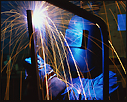Thermocouples are the most common, convenient, and versatile devices used to measure temperature. They convert units of heat into use able engineering units that serve as input signals for process controllers and recorders. Through selection of appropriate thermocouple wires and sheath components, thermocouples are suitable to be used in temperature ranges from (-200 to 2316) °C [-328 to 4200] °F.

A thermocouple consists of a welded 'hot' junction between two dissimilar metals, typically wires - and a reference junction at the opposite ends of the parent materials. Changes in temperature at the measurement junction induce a change in electromotive force (emf) between the other ends. The EMF appears across the free ends of the thermocouple wires where it is measured and converted into units of heat calibration.
There are two groups, the base metal thermocouples J, K, T, E and N and the precious metal thermocouples R, S, C and B. Each type has a characteristic (emf) vs. temperature curve and application range. The EMF curve is very dependent on the composition of each conductor. Type J and K are the most widely used in industrial applications. Type J (iron vs. copper-nickel (Constantan)) is versatile in that it can be used in both oxidizing and reducing atmospheres up to 1,400°F. Iron rusts at low temperatures where condensation can form. Type K (nickel-chromium (Chromel) vs. nickel aluminum (Alumel) can be used up to 2,300°F in an oxidizing or inert atmosphere.

Thermometrics produces a wide range of thermocouples for most market applications, including MgO (Magnesium Oxide), industrial and general purpose types. We also produce thermocouple assemblies for hazardous locations and other applications that require connection heads, protection tubes, thermowells and/or transmitters.
|
|
Type T TC in F |